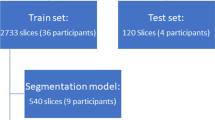Abstract
The assessment of bone lesion is crucial for the diagnostic and therapeutic planning of multiple myeloma (MM). \(^{68}\)Ga-Pentixafor PET/CT can capture the abnormal molecular expression of CXCR-4 in addition to anatomical changes. However, the whole-body detection of dozens of lesions on hybrid imaging is tedious and error-prone. In this paper, we adopt a cascaded convolutional neural networks (CNN) to form a W-shaped architecture (W-Net). This deep learning method leverages multimodal information for lesion detection. The first part of W-Net extracts skeleton from CT scan and the second part detect and segment lesions. The network was tested on 12 \(^{68}\)Ga-Pentixafor PET/CT scans of MM patients using 3-folder cross validation. The preliminary results showed that W-Net can automatically learn features from multimodal imaging for MM bone lesion detection. The proof-of-concept study encouraged further development of deep learning approach for MM lesion detection with increased number of subjects.
L. Xu and G. Tetteh—Contributed equally to this work.
Access this chapter
Tax calculation will be finalised at checkout
Purchases are for personal use only
Similar content being viewed by others
References
Callander, N.S., Roodman, G.D.: Myeloma bone disease, pp. 276–285. Semin Hematol Elsevier (2001)
Collins, C.D.: Problems monitoring response in multiple myeloma. Cancer Imaging 5, S119–S126 (2005)
Ltje, S., de Rooy, J.W., Croockewit, S., et al.: Role of radiography, MRI and FDG-PET/CT in diagnosing, staging and therapeutical evaluation of patients with multiple myeloma. Ann. Hematol. 88, 1161–1168 (2009)
Dimopoulos, M., Terpos, E., Comenzo, R., et al.: International myeloma working group consensus statement and guidelines regarding the current role of imaging techniques in the diagnosis and monitoring of multiple Myeloma. Leukemia 23, 1545–1556 (2009)
Horger, M., Claussen, C.D., Bross-Bach, U., et al.: Whole-body low-dose multidetector row-CT in the diagnosis of multiple myeloma: an alternative to conventional radiography. Eur. J. Radiol. 54, 289–297 (2005)
Dutoit, J.C., Verstraete, K.L.: MRI in multiple myeloma: a pictorial review of diagnostic and post-treatment findings. Insights Image 7, 553–569 (2016)
Healy, C.F., Murray, J.G., Eustace, S.J., et al.: Multiple myeloma: a review of imaging features and radiological techniques. Bone Marrow Res. (2011)
van Lammeren-Venema, D., Regelink, J.C., Riphagen, I.I., et al.: 18F-fluoro-deoxyglucose positron emission tomography in assessment of myeloma-related bone disease: a systematic review. Cancer 118(8), 1971–1981 (2012)
Vag, T., Gerngross, C., Herhaus, P., et al.: First experience with chemokine receptor CXCR4-targeted PET imaging of patients with solid cancers. J. Nucl. Med. 57, 741–746 (2016)
Philipp-Abbrederis, K., Herrmann, K., Knop, S., et al.: In vivo molecular imaging of chemokine receptor CXCR4 expression in patients with advanced multiple myeloma. EMBO Mol. Med. (2015)
Belton, A., Saini, S., Liebermann, K., et al.: Tumour size measurement in an oncology clinical trial: comparison between off-site and on-site measurements. Clin. Radiol. 58, 311–314 (2003)
Eadie, L.H., Taylor, P., Gibson, A.P.: A systematic review of computer-assisted diagnosis in diagnostic cancer imaging. Eur. J. Radiol. 81, e70–e76 (2012)
Petrick, N., Sahiner, B., Armato, S.G., et al.: Evaluation of computer-aided detection and diagnosis systems. Med. Phys. 40(8) (2013)
Taylor, A.T., Garcia, E.V.: Computer-assisted diagnosis in renal nuclear medicine: rationale, methodology, and interpretative criteria for diuretic renography. Semin. Nucl. Med. 44, 146–158 (2014)
Wang, S., Summers, R.M.: Machine learning and radiology. Med. Image Anal. 16, 933–951 (2012)
Kourou, K., Exarchos, T.P., Exarchos, K.P., et al.: Machine learning applications in cancer prognosis and prediction. Comput. Struct. Biotechnol. J. 13, 8–17 (2015)
Ju, W., Xiang, D., Zhang, B., et al.: Random walk and graph cut for co-segmentation of lung tumor on PET-CT images. IEEE Trans. Med. Imaging 24(12), 5854–5867 (2015)
Martínez-Martínez, F., Kybic, J., Lambert, L., et al.: Fully automated classification of bone marrow infiltration in low-dose CT of patients with multiple myeloma based on probabilistic density model and supervised learning. Comput. Biol. Med. 71, 57–66 (2016)
Ronneberger, O., Fischer, P., Brox, T.: U-net: convolutional networks for biomedical image segmentation. In: Navab, N., Hornegger, J., Wells, W.M., Frangi, A.F. (eds.) MICCAI 2015. LNCS, vol. 9351, pp. 234–241. Springer, Cham (2015). doi:10.1007/978-3-319-24574-4_28
Milletari, F., Navab, N., Ahmadi, S.A.: V-net: fully convolutional neural networks for volumetric medical image segmentation. In: 3DV, pp. 565–571 (2016)
Christ, P.F., et al.: Automatic liver and lesion segmentation in CT using cascaded fully convolutional neural networks and 3D conditional random fields. In: Ourselin, S., Joskowicz, L., Sabuncu, M.R., Unal, G., Wells, W. (eds.) MICCAI 2016. LNCS, vol. 9901, pp. 415–423. Springer, Cham (2016). doi:10.1007/978-3-319-46723-8_48
Author information
Authors and Affiliations
Corresponding author
Editor information
Editors and Affiliations
Rights and permissions
Copyright information
© 2017 Springer International Publishing AG
About this paper
Cite this paper
Xu, L. et al. (2017). W-Net for Whole-Body Bone Lesion Detection on \(^{68}\)Ga-Pentixafor PET/CT Imaging of Multiple Myeloma Patients. In: Cardoso, M., et al. Molecular Imaging, Reconstruction and Analysis of Moving Body Organs, and Stroke Imaging and Treatment. RAMBO CMMI SWITCH 2017 2017 2017. Lecture Notes in Computer Science(), vol 10555. Springer, Cham. https://doi.org/10.1007/978-3-319-67564-0_3
Download citation
DOI: https://doi.org/10.1007/978-3-319-67564-0_3
Published:
Publisher Name: Springer, Cham
Print ISBN: 978-3-319-67563-3
Online ISBN: 978-3-319-67564-0
eBook Packages: Computer ScienceComputer Science (R0)




